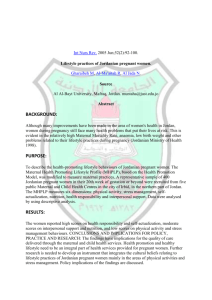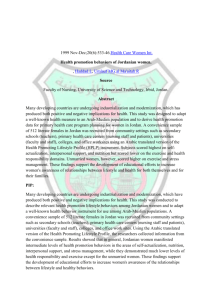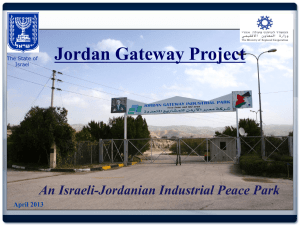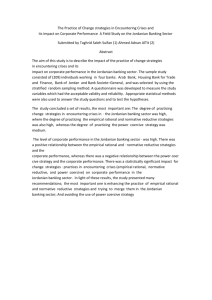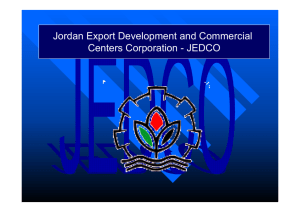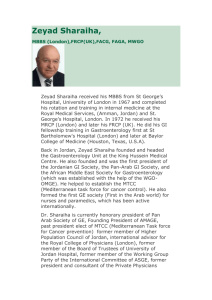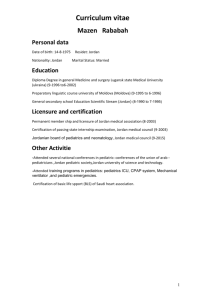advertisement
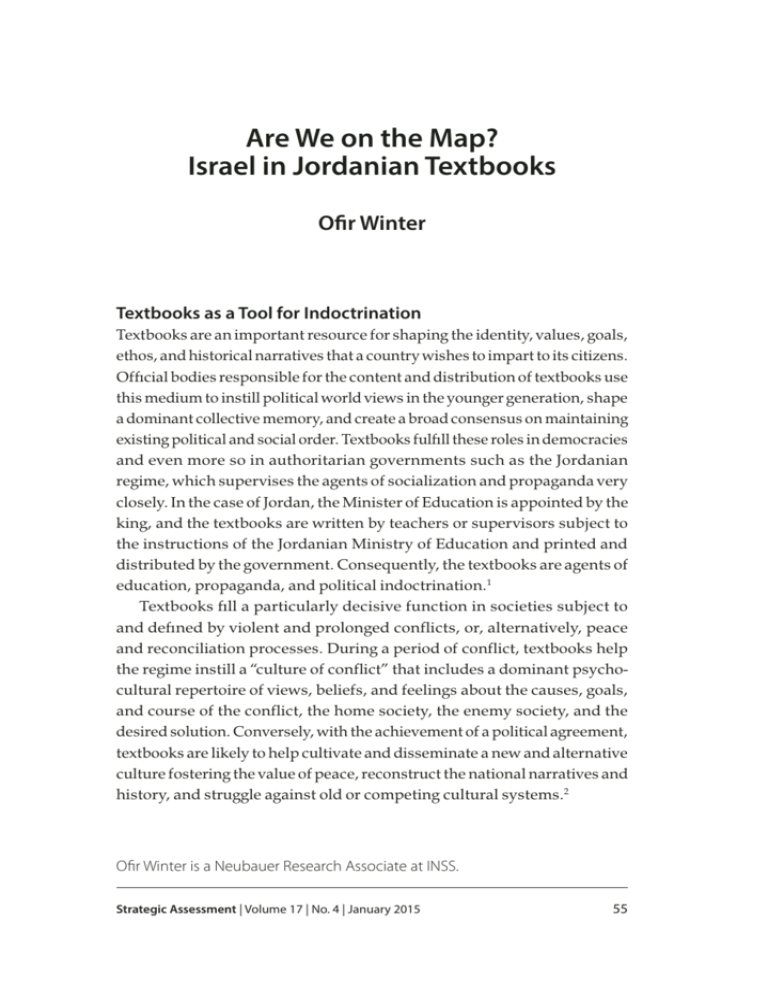
Are We on the Map? Israel in Jordanian Textbooks Ofir Winter Textbooks as a Tool for Indoctrination Textbooks are an important resource for shaping the identity, values, goals, ethos, and historical narratives that a country wishes to impart to its citizens. Official bodies responsible for the content and distribution of textbooks use this medium to instill political world views in the younger generation, shape a dominant collective memory, and create a broad consensus on maintaining existing political and social order. Textbooks fulfill these roles in democracies and even more so in authoritarian governments such as the Jordanian regime, which supervises the agents of socialization and propaganda very closely. In the case of Jordan, the Minister of Education is appointed by the king, and the textbooks are written by teachers or supervisors subject to the instructions of the Jordanian Ministry of Education and printed and distributed by the government. Consequently, the textbooks are agents of education, propaganda, and political indoctrination.1 Textbooks fill a particularly decisive function in societies subject to and defined by violent and prolonged conflicts, or, alternatively, peace and reconciliation processes. During a period of conflict, textbooks help the regime instill a “culture of conflict” that includes a dominant psychocultural repertoire of views, beliefs, and feelings about the causes, goals, and course of the conflict, the home society, the enemy society, and the desired solution. Conversely, with the achievement of a political agreement, textbooks are likely to help cultivate and disseminate a new and alternative culture fostering the value of peace, reconstruct the national narratives and history, and struggle against old or competing cultural systems.2 Ofir Winter is a Neubauer Research Associate at INSS. Strategic Assessment | Volume 17 | No. 4 | January 2015 55 Ofir Winter | Are We on the Map? Israel in Jordanian Textbooks Strategic Assessment | Volume 17 | No. 4 | January 2015 56 Jordanian Textbooks from the Period of Conflict to the Era of Peace Even two decades after the signing of the Jordan-Israel peace treaty, the shift from conflict to peace appears in Jordanian textbooks but little. While during the years of conflict the Jordanian educational system followed and spouted the dominant Arab nationalist line, the changes made after the peace treaty with Israel was signed were limited in number and quality. There is still a wide gap between the existing changes and the systematic fostering of a culture of peace, including empathy for Jews, acceptance of the Zionist enterprise, and recasting of the historical narratives to portray the past and present relations between the two sides in a new light. The limited scope of the educational reforms was due to cost-benefit political calculations, not ideological inhibitions. Measured and cautious changes, more so than those made in textbooks in Egypt, suited the interests of the Jordanian regime in three ways. First, a rapid change from the traditional image of Israel as a foreign, colonial, exploitative, and threatening entity to its new status as a partner in peace worthy of normalized relations was liable to arouse strong opposition among the Jordanian public. Second, the failure of Israeli-Palestinian negotiations on a permanent settlement made it difficult for the Jordanian regime to gain legitimacy for far reaching educational reforms. Finally, the pressure exerted by those opposed to the peace treaty deterred the regime from controversial measures liable to provide political opponents with a weapon that could prove embarrassing in domestic public opinion. Study of the Arab-Israeli conflict in the Jordanian educational system began as early as the 1950s. Despite the intimate clandestine relations developed from the mid-1960s between King Hussein and Israeli leaders, until the moves toward peace, Jordanian textbooks served as a tool for fostering and spreading a “culture of conflict” and incited hostility, hatred, and demonization of Israel and the Jews. The Jordanian Law of Education, passed in 1964, stated that the “Arab character of Palestine” and the “effort to return it to the bosom of the Arab fatherland” were the foundations of the Jordanian educational philosophy.3 Accordingly, Zionism was described in the textbooks as an abominable reflection of Western colonialism, a movement that stole Palestine from its original inhabitants, sought to disrupt Arab unity, and expand at the Arabs’ expense. Repeating common anti-Semitic motifs and without any real distinction between Judaism and Zionism, the Jews were depicted as controlling the financial markets and the global media and spreading moral corruption among civilization.4 The Ofir Winter | Are We on the Map? Israel in Jordanian Textbooks 57 Strategic Assessment | Volume 17 | No. 4 | January 2015 struggle against the Jews was explained as a religious-historical struggle from the days of Muhammad, when the Jews violated their agreements with the Muslims and made alliances with the infidels.5 The idea of peace with Israel was absent from the textbooks, even though in 1967 Jordan accepted UN Security Council Resolution 242, which was based on the “land for peace” formula. Furthermore, the Camp David agreements between Israel and Egypt were denounced for their serious shortcomings: recognition of Israel, abandonment of Jerusalem, neglect of the Palestinians’ rights, acceptance of a violation of the territorial continuity between Arab countries, and a blow to Arab unity.6 The maps that appeared in the Jordanian textbooks underwent a gradual transformation over the years, reflecting the changes in the kingdom’s actual borders as well as the symbolic borders that the regime sought to sketch in order to reflect the affinity between the Jordanian identity and the Palestinian identity. In the maps published in the 1950s and 1960s, all the territory of Mandatory Palestine was labeled as Jordan. These maps reflected non-recognition of the legitimacy of Israeli sovereignty over the land, the belief that all the territory up to the Mediterranean coastline belonged to Jordan, and the denial of the competing Palestinian and Egyptian claims to sovereignty over all or part of the land.7 After the Six Day War, the map of Jordan shrank to the borders of the 1949 ceasefire lines, including the West Bank and Jerusalem. The rest of the land of Israel appeared as “Occupied Palestine.”8 The portrayal of the kingdom within the borders known to us now began to appear in the textbooks only after the decision to disengage from the West Bank in July 1988. For its part, the State of Israel continued to be absent from the maps in its real name, and to appear as Palestine.9 In the framework of the peace treaty (Section 11C), Jordan and Israel undertook to refrain from expressions of hostility in governmental publications, including textbooks. Under pressure from Israel, Jordan acceded to a number of nominal corrections. Most of the content typical of Jordanian textbooks during the period of conflict, however, which was ostensibly inconsistent, at least in spirit, with the peace policy it had adopted, was left unchanged. This was confirmed by Munther al-Masri, Jordanian Minister of Education in 1996-1998, who said, “There was no systematic change in study programs after the peace treaty, except for slight changes corresponding to the new status [of relations] commenced with Israel.”10 The changes nevertheless implemented in the honeymoon period of the peace included omission from the textbooks of the phrase “the Zionist Ofir Winter | Are We on the Map? Israel in Jordanian Textbooks 58 Strategic Assessment | Volume 17 | No. 4 | January 2015 enemy,” and partial omission of the Quran verses and traditions used to whip up hatred of the Jews and arouse support for jihad against them.11 Similarly, in accordance with Jordan’s position on Jerusalem, statements by King Hussein calling for leaving sovereignty over the holy places of the three monotheistic religions “in the hands of God” – substituted for the traditional Jordanian demand for exclusive Arab-Muslim sovereignty over the Holy Basin – were cited.12 Following the September 11, 2001 terrorist attacks in the US, the Jordanian Ministry of Education decided to enhance its education for peace and tolerance as Islamic values advocated by the kingdom, although devoid of any explicit link to the controversial peace relations with Israel.13 While these changes were taking place, the Jordanian Education Law, passed in April 1994, a few months before the signing of the peace treaty, emphasized Jordan’s loyalty to the traditional line, which held that “the Palestinian problem is a fateful problem for the Jordanian people, and the Zionist aggression against Palestine is a political, military, and cultural challenge for the Arab and Islamic nation in general, and in particular for Jordan.”14 In the spirit of the law, which reflected Jordan’s desire to prove that its pursuit of peace did not constitute a deviation from its commitment to the Palestinians, the textbooks in the 1990s and the first decade of the 21st century continued to portray Israel as an occupying and aggressive country seeking to destroy the original inhabitants of the land, describe Zionism as a racist ideology designed to subject all other peoples to the Jews and steal their property, and indiscriminately attribute to Jews negative character traits.15 The maps Between May and in the textbooks continued to display “Palestine” September 2014, the as a country on the kingdom’s western border, Jordanian Ministry of and refrained from explicit recognition of Israeli Education launched a sovereignty. In contrast to Egyptian history books, number of measures that which emphasized the positive contribution of peace it had shunned during with Israel to the essential interests of Egypt, the Jordanian history books were silent and refrained two decades of peace. from clarifying the nature of the current relations between Jordan and Israel following the peace agreement, while at the same time highlighting the kingdom’s role in the wars “for the defense of Palestine and Jerusalem.”16 Ofir Winter | Are We on the Map? Israel in Jordanian Textbooks Between May and September 2014, the Jordanian Ministry of Education launched a number of measures that it had shunned during two decades of peace, which may well signal the beginning of a positive change in the status of Israel in the Jordanian textbooks. As part of the changes, the Ministry removed from the curriculum lessons that promoted the ethos of struggle against Israel. In an unprecedented move, it distributed a study guide for teachers and educational booklets that included a map in which Israel was explicitly shown by name, and it banned the inclusion of a book denouncing the peace with the Jews in school libraries. While these measures did not amount to a comprehensive reform in the attitude toward Israel in Jordanian textbooks, they did constitute some improvement in Israel’s status at a time when Operation Protective Edge was taking place and the royal palace’s public rhetoric was highly critical of Israel. The public criticism by the royal household of Israel’s policy in the Palestinian arena during the summer of 2014, which was designed to have a calming effect on Jordanian popular opinion, does not contradict its basic desire for long term educational changes regarding Israel’s image. A circumstantial analysis of the Jordanian regime’s measures suggests that although their rationale was not articulated publicly, they were adopted as part of an enduring trend to reduce the centrality of the conflict with Israel in the Jordanian educational experience, a conflict that nurtures the radical Islamic forces posing a growing threat to the kingdom’s stability. Evidence of the public weight of these educational changes can be found in the debate between the Jordanian regime and the opposition forces, headed by the Muslim Brotherhood and the trade unions. The latter elements denounced the changes in the textbooks for three main reasons: first, it was alleged, they reflect surrender to external foreign pressure based on American-Israeli interests; second, they violate sacred religious and national values at the heart of the Jordanian identity; third, they weaken the younger generation in the struggle against Israel and undermine its spirit of sacrifice for Palestine. In response to the criticism, the regime’s spokesman stressed the ongoing Jordanian commitment to the Palestinian issue, and rejected the accusations concerning the effects of the external pressure allegedly exerted on the kingdom. They also belittled the value of the changes, or alternatively, used semantic apologetics by claiming that what was involved was “enhancement and development” of textbooks by inserting new content, not “changes” or “revisions.” 59 Strategic Assessment | Volume 17 | No. 4 | January 2015 Educational Reforms in Light of the Struggle against Radical Islam Ofir Winter | Are We on the Map? Israel in Jordanian Textbooks Strategic Assessment | Volume 17 | No. 4 | January 2015 60 The change in Israel’s status in the Jordanian textbooks was not unrelated to the strengthening of radical Islam in the region and the threats facing Jordan. In 2014, the battles in Iraq and Syria neared the kingdom’s borders, and the increasingly brazen Islamic State soldiers extended their range of targets to Kurdistan and Lebanon. Along with the external threats, the Jordanian regime faced a no less troublesome threat on the internal front from the followers of the Salafi-jihadi ideology, mainly in the cities of Ma’an and al-Zarqa. A considerable number of young Jordanians have drawn encouragement and inspiration from the successes of the Islamic State organization and Jabhat al-Nusra in Iraq and Syria, and several thousand of them even went to fight in its ranks. The economic and social distress in Jordan, reflected in high rates of poverty, unemployment, and inflation, has also contributed to the growing religious extremism in the country.17 The external dangers on its unstable borders with Syria and Iraq, as well as pockets of Salafi-jihad support inside Jordan, have highlighted Israel’s standing as a strategic partner for the kingdom’s security and economic interests, and the state of peace with Israel as a guarantee of stability on its western border. At the same time, the ongoing public agitation on the Israeli-Palestinian conflict has become more troublesome than ever for the Jordanian regime, due to its role in inciting the religious radicalism threatening to spread in Jordan. Senior Jordanian spokesmen have mentioned the Palestinian issue as a factor in the rise of the Islamic State, the strengthening of radical terrorist groups, and regional instability.18 King Abdullah himself stated, “The many conflicts in the region constitute a convenient climate for extremism and terrorism, and this requires serious action to strengthen the middle of the road and moderation.”19 In view of the growing anxiety in Jordan about the dangers threatening it from both without and within, the government in 2014 began to formulate a multi-dimensional plan of operation for the struggle against radical Islam. The plan had legal, economic, military, and educational components. In April, the Jordanian parliament approved an amendment to the AntiTerrorism Law that made it easier to arrest and put on trial anyone who joins jihadist organizations, propagates their ideas, gives them money, or helps recruit and train their operatives within Jordan or elsewhere. In October, King Abdullah cited an urgent need to create new jobs as part of the struggle against religious extremism. That same month, Jordan joined the international coalition in the war against the Islamic State, and in November, the government approved training for members of Ofir Winter | Are We on the Map? Israel in Jordanian Textbooks Strategic Assessment | Volume 17 | No. 4 | January 2015 61 the Iraqi army and the stationing of six French warplanes on its territory. In addition to these measures, the regime decided to promote reforms in study programs in the schools and universities in the belief that the younger generation was overly exposed to the influence of radical Islamic ideologies.20 Jordanian Minister of the Interior Hussein Hazza al-Majali stated in August 2014 that the struggle against extremism and terrorism was not limited to the use of military force; it should also be conducted in the ideological sphere. He added that this was a collective responsibility of all the country’s agencies, educational institutions, mosque preachers, universities, discussion forums, social organizations, and the family.21 For his part, King Abdullah stressed that the campaign against terrorism and extremism included both military and educational aspects, and predicted that in contrast to the military campaign, which would not take a long time, “the ideological campaign” to institute moderate Islam can be expected to last 10-15 years.22 It therefore appears that the series of changes in 2014 in the portrayal of Israel in Jordanian textbooks constitutes an integral part of the ideological struggle conducted by the Jordanian regime against radical Islam and the threat posed by the Islamic State. The first public outcry occurred in May 2014, after a letter from the Jordanian Ministry of Education to high schools was leaked. This letter instructed the schools to refrain from buying the book The Jews: No Agreements It appears that the series and No Treaties for their libraries, insofar as it was of changes in 2014 in inconsistent with the state educational philosophy. the portrayal of Israel The Muslim Brotherhood warned that banning the in Jordanian textbooks purchase of a book revealing the true nature of the constitutes an integral Jews as people with whom treaties could not be part of the ideological conducted would prevent students from recognizing the real face of “the occupying enemy.”23 Muslim struggle conducted by Brotherhood leader Hamza Mansour sent a letter to the Jordanian regime the Jordanian Minister of Education condemning the against radical Islam and Ministry’s order. He said that the Quran contained the threat posed by the many verses showing that the Jews did not honor Islamic State. their treaties, to the extent that “violation of treaties and evading undertakings is second nature for them,” as stated in verse 100 of the “The Cow” Surah (concerning the breach of the Jews’ treaty with the Prophet Mohammed): “And every time they made a pledge some of them pushed it aside, and many of them do not believe.”24 Ofir Winter | Are We on the Map? Israel in Jordanian Textbooks Strategic Assessment | Volume 17 | No. 4 | January 2015 62 Three months later, before the beginning of the 2014-2015 school year, a study guide for teachers containing supplementary materials for the geography curriculum for junior high schools and two study booklets for elementary schools and junior high schools dealing with hygiene and the damage caused by smoking were distributed. In unprecedented fashion, these contained a map of the region in which Israel was explicitly displayed, i.e., no longer as Palestine. Israel was portrayed in the pre-Six Day War borders, without the Golan Heights, the West Bank, and the Gaza Strip. Only next to the Golan Heights was it stated that the territory was “occupied by Israel.” In response, the Anti-Zionism and Racism Society, affiliated with the Muslim Brotherhood, stated that the use of the strange name “Israel” was designed to weaken the attachment to Palestine among the nation and the people.25 The Association called the study booklet an anti-educational plot for normalization and the spreading of ignorance, and called on teachers not to distribute it to their students and to warn them of its dangers.26 Following the protests, the Jordanian Ministry of Education disavowed the booklets, claiming that it had not approved them.27 Furthermore, in the summer of 2014, the Jordanian Ministry of Education removed texts dealing with Jerusalem and Firas al-Ajlouni, commander of an air battle squadron who was killed in the 1967 War and was considered a Jordanian national hero and a symbol of Jordan’s commitment to the Palestinian cause, from third grade Arabic study booklets.28 This measure led to a protest demonstration by opposition organizations in front of the Jordanian Ministry of Education, under the heading, “No to Normalization in the Jordanian Study Programs.”29 The protestors accused the regime of having ulterior motives. For example, Thabahtoona, a student protest organization, expressed its suspicion that the removal of the al-Ajlouni lesson was the result of cooperation between the Jordanian government and the US Agency for International Development (USAID), as part of an agreement for $235 million over five years to improve education in the kingdom.30 Jordanian Teachers Union chairman Hussam Masheh attributed the changes to external pressure on Jordan to revise its study programs. He mentioned his longing for the old textbooks “that dealt extensively with the Palestinian problem and the dangers of the Zionist enemy,” and expressed regret that “we no longer see these subjects in the study programs, which are now subject to foreign dictates.”31 A publicist’s article on an independent Jordanian website wondered whether the erasing of al-Ajlouni’s name constituted “a precedent for a decision to allow international forces to use Ofir Winter | Are We on the Map? Israel in Jordanian Textbooks Strategic Assessment | Volume 17 | No. 4 | January 2015 63 our land to attack fellow Arab Muslims in neighboring countries, on the pretext of an attack against the Islamic State and similar organizations.”32 Islamist groups regarded the removal of the lesson on al-Ajlouni as a typical example of the Jordanian regime’s efforts to repress the ethos of struggle against Israel. A summons to a protest demonstration in front of the Ministry of Education organized by the Anti-Zionism and Racism Society asserted that the revisions in textbooks were no coincidence; they were the result of a regular policy designed to uproot the spirit of resistance from the consciousness of the younger generation and replace it with a mood of surrender, disguised by slogans like “common universal values” and “culture of peace.” The summons stated that the regime’s measures “contributed to creating a generation of rootless cosmopolitans” and “education for not belonging to the fatherland and the soil.”33 In a speech at the demonstration, al-Ajlouni was described as “a paragon of the struggle against the sworn Zionist enemy and for the defense of Palestinian soil, the main problem of the Jordanian people,” and concern was expressed that removal of his biography constituted “part of an organized process of reformulating study programs to fit the peace treaty with Israel and the Zionist-American demands for According to the the elimination of any study material whipping up Jordanian establishment’s hatred of the Zionist entity.”34 An article in Assabeel, long term perspective, the Muslim Brotherhood publication, stated that in it is both possible and contrast to the Jordanian pilots of today, al-Ajlouni desirable to implement “was not satisfied with airshows, and would not have allowed his airplane to rust away unused in a gradual measures to warehouse through the weakness of diplomats and reduce the conscious the fears of leaders.”35 and symbolic intensity Faced with this wave of criticism, the Jordanian of the conflict with Ministry of Education hurriedly made clear that Israel, even in a political the study unit involved was removed as part of a situation where no general replacement of textbooks for grades 1-3 for pedagogical, not political, reasons involving Israeli-Palestinian peace techniques for teaching reading. The Ministry also settlement is on the emphasized that it cherished the spirit of sacrifice horizon. represented by al-Ajlouni, and cited the school in Amman named after him as evidence.36 Jordanian Minister of Education Mohammad Thneibat promised that the Jordanian study programs “would Ofir Winter | Are We on the Map? Israel in Jordanian Textbooks Strategic Assessment | Volume 17 | No. 4 | January 2015 64 continue to be replete with material about sacrifice and national foundations, and would put a maximal emphasis on the Palestinian problem.”37 Conclusion Regardless of their limited nature, the changes in the portrayal of Israel in the Jordanian educational system are singular developments. While previous revisions in the textbooks occurred as a result of Israeli pressure in the second half of the 1990s, during the honeymoon period of the JordanianIsraeli peace treaty, the recent revisions were a voluntary initiative of the Jordanian regime, even though they were implemented during a period of colder formal relations with Israel. This indicates that internal political interests are likely to bring the Jordanian regime to promote educational changes concerning recognition of Israel and moderation of the hostility to it, despite the concomitant sharp public protests. According to the Jordanian establishment’s long term perspective, it is both possible and desirable to implement measures for gradually reducing the conscious and symbolic intensity of the conflict with Israel, even in a political situation where no Israeli-Palestinian peace settlement is on the horizon. Despite the measures taken over the past year, however, there is much ground to cover before a state is reached in which Jordanian education advocates reconciliation and good neighbor relations with Israel. At this stage, it is still difficult to assess whether the recent changes in textbooks indicate the beginning of a wave of broad reforms likely to help strengthen the peaceful relations between Israel and Jordan in the future, or whether only a set of limited and individual actions is involved. The royal house’s main motivation for revising its study programs in the framework of this conflict with radical Islam, combined with the strategic interests shared by Israel and Jordan, is likely to encourage a continuation of this trend; on the other hand, the powerful public protests aroused in Jordan by any move in the direction of reconciliation with Israel constitute a formidable stumbling block. Notes The author would like to thank Dr. Eldad Pardo, head of research at IMPACT-SE (Institute for Monitoring Peace and Cultural Tolerance in School Education), for his assistance. 1 Michael Winter, “The Arab Self-Image as Reflected in Jordanian Textbooks,” in The Hashemites in the Modern Arab World, eds. Asher Susser and Aryeh Ofir Winter | Are We on the Map? Israel in Jordanian Textbooks 3 4 5 6 7 8 9 10 11 12 13 14 15 65 Strategic Assessment | Volume 17 | No. 4 | January 2015 2 Shmuelevitz (London: Frank Cass, 1995), pp. 207, 209; Michael Apple, Official Knowledge: Democratic Education in Conservative Age (New York: Routledge, 1993), pp. 1-14, 44-63; Elie Podeh, “Israel in the Mirror: The ArabIsraeli Conflict in History Textbooks in Egypt (1952-1998),” in Religion and State in the Middle East, ed. David Menashri (Tel Aviv: Kibbutz HaMeuhad, 2006), pp. 219, 226; Iris Fruchter-Ronen, “Between the Jordanian and the Palestinian Homelands: Jordan Textbooks as a Tool for Creating a National Identity,” Studies in Zionism, the Yishuv, and the State of Israel 22 (2012): 152-55. Daniel Bar-Tal, Living with the Conflict (Jerusalem: Carmel, 2007), pp. 16-50, 303-15. “The 1964 Law of Education,” Star Times, www.startimes.com/f.aspx?t=33779. ‘Abbas al-Kurd, The History of the Arabs and the Muslims (Amman: al-Mateba al-Merqaziya, 1991, 1st ed. 1966), pp. 172-73; Fruchter-Ronen, “Between the Jordanian and the Palestinian Homelands,” p. 161. ‘Abd al-‘Aziz al-Khayyat et al., Islamic Education for 10th Grade (Amman: Sharikat al-Matabi‘ al-Namudhijiyya, 14th ed. 1992, 1st ed. 1973), pp. 182-89. Al-Kurd, The History of the Arabs and the Muslims, pp. 194-95. Riad M. Nasser, Palestinian Identity in Jordan and Israel (New York and London: Routledge, 2005), pp. 74-75; Betty S. Anderson, “Writing the Nation: Textbooks of the Hashemite Kingdom of Jordan,” Comparative Studies of South Asia, Africa and the Middle East 21, no. 1&2 (2001): 9, 13. For example, Anmar al-Kilani et al., Social Education: Our Land (Amman: alMatba‘a al-Wataniyya, 8th ed. 1990, 1st ed. 1980), p. 8. Jordanian Ministry of Education, Our Arab Language (Amman: Wizarat alTarbiyya wal-Ta‘alim, 1st ed. 1994), pp. 15-17; Riad Nasser, Recovered Histories and Contested Identities (Plymouth: Lexington Books, 2011), p. 143. Muhammad ‘Uday al-Rimawi, “Change in Study Programs after the Treaty: Strengthening Ideas of Good Neighbors and Tolerance, and Eliminating the Resistance and Jihad,” al-Sijill 47, October 16, 2008, www.al-sijill.com/ sijill_items/sitem4154.htm. Ibid.; Mahmud al-Shar‘an, “Erasing Jordan and Palestine from the Study Programs and Receiving Aid from Israel,” al-Akhbar, August 17, 2014, www. alakhbar.com/node/215750. Yasin Ayish et al., Literary and Linguistic Culture for the 11th Grade (Amman: Wizarat al-Tarbiya wal-Ta‘alim, 1997, 1st ed. 1995), p. 81. Hasan Fattah, “Jordan Reconsidering the Religious Studies Programs in Order to Encourage Values of Openness and Combat Extremism,” a-Sharq al-Awsat, June 13, 2005, classic.aawsat.com/details.asp?issueno=9532&artic le=305348#.VDl35U0cTL8. Jordanian Ministry of Education, “Education Law Number 3 for 1994 and its Amendments,” no date, www.moe.gov.jo/Departments/ DepartmentsMenuDetails.aspx?MenuID=324&DepartmentID=5. Georg-Eckert-Institut, “Educational Sector, Reforms, Curricula and Textbooks in Selected MENA Countries: Images of ‘Self’ and ‘Other’ in Ofir Winter | Are We on the Map? Israel in Jordanian Textbooks Strategic Assessment | Volume 17 | No. 4 | January 2015 66 16 17 18 19 20 21 22 23 24 Textbooks of Jordan, Egypt, Lebanon and Oman, ” Eckert.Analysen 2011/1, October 2009, www.edumeres.net/urn/urn:nbn:de:0220-2011-00173; Mubarak Muhmmad al-Tarawna et al., The History of the Arabs and the Modern World for the 11th Grade: Part One (Amman: Wizarat al-Tarbiya and al-Ta‘lim, 1996), pp. 117-21; ‘Ali Muhmmad al-Sawa et al., The Islamic Sciences for the 11th Grade (Amman: Wizarat al-Tarbiya wal-Ta’alim, 1996, 1st ed.), pp. 426-36. Fruchter-Ronen, “Between the Jordanian and the Palestinian Homelands,” pp. 173-74; Podeh, “Israel in the Mirror,” pp. 243-46; “Educational Sector, Reforms, Curricula and Textbooks in Selected MENA Countries.” David Schenker, “Preventing ISIS Inroads in Jordan, ” PolicyWatch 2311, September 3, 2014, www.washingtoninstitute.org/policy-analysis/view/ preventing-isis-inroads-in-jordan. “Jordanian Minister of State for Media Affairs and Communications Calls for a Struggle Against Extremism in the Region,” al-Arab, February 9, 2014, www.alarab.co.uk/?id=35797; Raniya Tadrus, “Jordan Chief of Staff Muhammad al-Zaban: Jordan Will Not Allow Terrorist Groups to Get Close to its Borders or to Threaten its Security,” al-Raʼy, September 24, 2014, www. alrai.com/article/671423.html. Walaʼ Abu-Satit, “King of Jordan Cite the Need for Joint Arab Cooperation,” veto, March 25, 2014, www.vetogate.com/925863. Hamza al-‘Akayla, “‘Erem’ Published the New Jordanian Law for the Struggle against Terrorism,” Erem, March 4, 2014, www.eremnews. com/?id=29405; Media & Communication Directorate, “King: Awareness of Our Jordanian Citizens is the Basis for Defense of Our Supreme Interests,” October 20, 2014, www.kingabdullah.jo/index.php/ar_JO/news/view/ id/11841/videoDisplay/1.html; Mahmud Maghrabi, “Efforts to Revise the Plan for Combating Extremism in Jordan,” Khaberni, September 8, 2014, www.khaberni.com. “Jordanian Interior Minister: Fight Extremism with the Ideological Weapon, Not a Gun,” al-Wasat Online, August 3, 2014, www.alwasatnews.com/4348/ news/read/908906/1.html. Media & Communication Directorate. Hadil al-Dasuqi, “The Ministry of Education is Removing the Book The Jews: No Agreements and No Treaties,” Assabeel, May 3, 2014, snipurl.com/29k7c7u; Kull-al-Urdun, “Committee for Considering Purchase of the Book The Jews: No Agreements and No Treaties for the Schools,” May 6, 2014, www.allofjo.net/ index.php?page=article&id=69057. The Islamic Action Front, “Mansur Condemned the Removal of the Book The Jews: No Agreements and No Treaties, by the Ministry of Education,” May 5, 2014, snipurl.com/29kusx4; Ahmed Ali, Al-Qur’an: A Contemporary Translation (Princeton: Princeton University Press, 1994), p. 23. Ofir Winter | Are We on the Map? Israel in Jordanian Textbooks 67 Strategic Assessment | Volume 17 | No. 4 | January 2015 25 “Lecture and Demonstration against the Insertion of Normalization into the Jordanian Study Program,” al-Sawt al-‘Arabi al-Hurr, September 16, 2004: freearabvoice.org/?p=3637. 26 “The Ministry of Education is Distributing Textbooks with the Word ‘Israel’ Appearing on the Map of Palestine,” Kull-al-Urdun, August 11, 2014, www. allofjo.net/index.php?page=article&id=75288. 27 Note that the two study booklets also appeared and aroused a storm in 2012, possibly as a trial balloon: Ghada Abu-Yusuf, “The Ministry of Education Expresses Surprise at the Reappearance of an Issue from 2012 Concerning a Booklet in which the Name ‘Israel’ Appears,” al-Dustur, August 28, 2014, snipurl.com/29k7dln. 28 “The Study Programs in Jordan are Replacing Palestine with Israel,” alJazeera.net, September 16, 2014, snipurl.com/29k7ddc. 29 Ghada Abu-Yusuf, “Demonstration in front of the Ministry of Education Against Removal of an ‘Al-Ajlouni’ Lesson from the Study Program,” alDustur, September 22, 2014, snipurl.com/29k7djg. 30 Thabahtoona, “Thabahtoona asks al-Denibath: Is Elimination of the alAjlouni Lesson the Result of American-Jordanian Cooperation?” September 14, 2014, www.thab7toona.org/?p=1036. 31 “Criticism of the Revision of Study Programs in Jordan,” al-Jazeera.net, September 14, 2014, snipurl.com/29k7d9r. 32 Suhir Jaradat, “The Name of the Martyr Was Omitted,” September 20, 2014, snipurl.com/29k7d3x. 33 “Lecture and Demonstration against the Insertion of Normalization into the Jordanian Study Program.” 34 Thabahtoona, “Demonstrators in front of the Ministry of Culture: Don’t Erase al-Ajlouni from Our National Memory,” September 21, 2014, www. thab7toona.org/?p=1061. 35 Muhmmad Muhaysan, “The Martyr Firas al-Ajlouni,” Assabeel, September 16, 2014, snipurl.com/29k7cvn. 36 “A Clarification by the Ministry of Education Concerning the Removal of a Text about the Dead War Hero Firas al-Ajlouni,” al-Raʼy, September 16, 2014, www.alrai.com/article/670039.html. 37 “Thneibat in Tough Message to Masheh: Don’t Intervene in Policy and Study Programs,” Sada al-Sha‘b, September 22, 2014, snipurl.com/29k7bnh.
